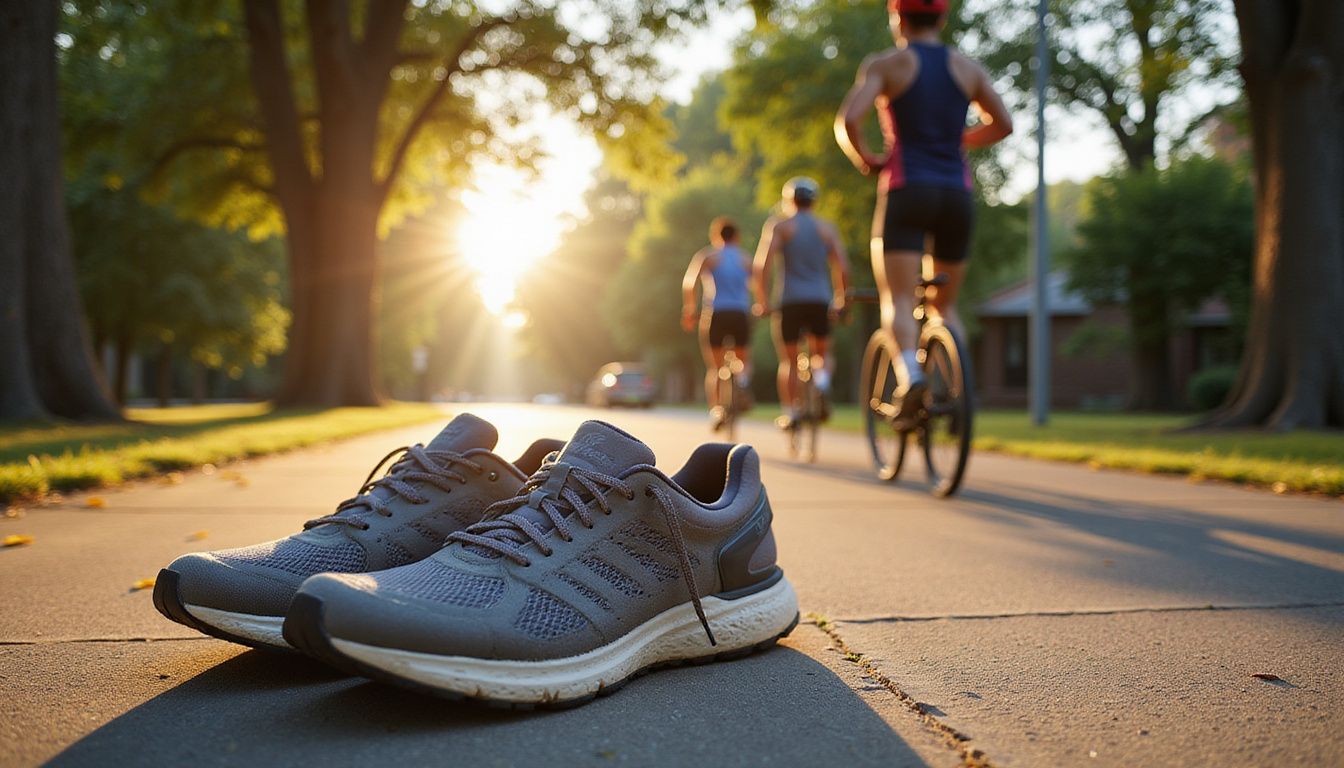Walking And Weight Loss: Burn Fat And Lose Weight By Walking
Our Nutrition Assistant AI Suite will transform your body. You will lose fat, get toned, and build muscle. Gain confidence and optimal health.
Plateaus can make weight loss feel out of reach. Walking for weight loss gives you a simple, low-impact way to burn fat and regain momentum. A brisk 30-minute walk can add about 150 extra calories burned to your day, which adds up over time.
In this guide, you will learn how walking burns calories, why it helps protect muscle, and how to turn daily walks into steady results. Small changes, like a faster walking pace or hills, can help you burn more calories and lose weight sooner.
Key Takeaways
- Thirty minutes of brisk walking can burn around 150 extra calories a day, which supports weight loss (Mayo Clinic, U.S. Department of Health and Human Services).
- Moderate walking three times a week for 12 to 16 weeks can reduce visceral belly fat, which supports heart and metabolic health (2021 research).
- Brisk walking at 3 to 4 miles per hour and interval power walking both increase calorie burn. Intervals often lead to greater fat loss than a steady pace.
- Pedometers or fitness trackers help you hit step goals. Many adults do well aiming for 7,000 to 13,000 steps a day for weight management.
- Weighted vests under 10 percent of your body weight can increase calorie burn, build strength, and help preserve bone density during walks (2024 clinical trial).

Why Walking Is a Great Way to Lose Weight

Walking is a joint-friendly form of exercise that supports weight loss and heart health. Daily walks improve fitness, lower stress, and make an active lifestyle easier to maintain.
How does walking burn calories efficiently?
Every step uses energy. The faster you walk or the longer you go, the more calories you burn. According to Mayo Clinic estimates, a 30-minute brisk walk can add about 150 calories to your daily burn.
A 2021 analysis found walking and running burn similar calories per mile, roughly 107 calories for many adults. Hills increase the workload because you must push against gravity, which raises energy use. Consistent walks turn those small burns into real changes over weeks and months.
Switching from easy strolls to brisk, hilly routes often raises energy, improves fitness, and supports steady weight loss.
How does walking boost metabolism?
Walking helps you keep lean muscle. Muscle tissue burns more calories at rest than fat, which raises your basal metabolic rate, the calories you burn while resting. Dieting without activity can lower this rate, but regular walking helps prevent that drop.
Active adults who walk most days tend to keep higher daily energy expenditure than those who sit more. Aiming for at least 150 minutes a week of moderate aerobic exercise, such as brisk walking, supports weight management and lowers the risk of obesity and diabetes.
Short walks after meals can reduce sluggishness and curb appetite, which helps you stay on track with your plan.
How does walking help preserve lean muscle?
Diet-only weight loss often reduces both fat and muscle. Since muscle burns more calories at rest, protecting it helps prevent future weight gain. Regular walking signals your body to maintain muscle while you lose fat.
The U.S. Department of Health and Human Services recommends 150 to 300 minutes of moderate activity per week. That level supports muscle maintenance. A daily walking program also lowers the risk of age-related muscle loss, called sarcopenia.
Adding two brief strength sessions each week, paired with steady steps per day, can further protect muscle and improve metabolic health, as shown in several randomized controlled trials from the National Institutes of Health.
The Science Behind Walking and Fat Burning
Walking raises your heart rate and increases energy use. Over time, those extra calories help reduce body fat, including stubborn belly fat.
How does walking create a calorie deficit?
Weight changes depend on a calorie deficit, which means you burn more than you eat. A 30-minute walk at around 4 miles per hour may use 150 to 200 calories, depending on your body weight and speed.
Cutting calories while adding regular walks encourages your body to use stored fat for energy. Many experts suggest building toward about 250 minutes a week of moderate activity for stronger results. Pair that with the Dietary Guidelines for Americans to guide your food choices.
Weight loss requires burning more calories than consumed each day.
How does walking affect visceral and belly fat?
Walking helps reduce visceral fat, the deeper belly fat that surrounds organs. High levels of visceral fat raise the risk of diabetes and heart disease. Waist lines over 40 inches for men or 35 inches for women suggest increased risk.
Research in 2021 shows 30 to 60 minutes of moderate walking, three times weekly for 12 to 16 weeks, can shrink this type of adipose tissue. Results improve further when you combine walking with a balanced eating plan.
Increasing weekly minutes often leads to greater change, since fat loss responds to consistent dose. Many people notice clothes fit better and waist size drops with steady daily walks.
Types of Walking for Weight Loss
Different styles of walking help you reach your goals. Pick an approach that matches your fitness level and schedule, then progress step by step.
What is brisk walking and how does it help?
Brisk walking means you can talk but not sing. The National Health Service defines this pace as moderate intensity. Walking at a brisk pace keeps your heart rate up, which supports weight loss and better cardiovascular fitness.
About 30 minutes of brisk walking can burn roughly 150 calories. The U.S. Department of Health and Human Services advises at least 150 minutes of moderate aerobic activity per week. Wearables and apps help you stay in the target zone and track progress.
Brisk walking can burn fat while supporting lean muscle. Many walkers find that using simple step goals keeps motivation high.
How does power walking in intervals boost fat loss?
Interval walking alternates between a comfortable pace and short bursts of faster steps, often 10 to 15 seconds at a time. This raises your heart rate, which increases calorie burn more than a steady pace.
The CDC encourages 150 minutes of moderate-intensity aerobic exercise each week. Intervals help you meet this goal while improving fat loss. Begin with brief surges and longer easy sections. As you adapt, extend the faster segments.
Studies show people with excess weight who use intervals often lose more fat than those who walk at one speed. Many walkers see waistline changes faster once they add intervals to their routine.
Why is walking uphill effective for weight loss?
Adding an incline raises intensity and calorie burn without needing a longer walk. Hills recruit your glutes, hamstrings, and calves, which increases work per minute compared to level ground.
For example, a 155-pound person may burn about 267 calories during a brisk hour on flat terrain, and well over 400 calories on a steep hill. Taking stairs offers similar benefits in less time.
Use hilly routes or set a treadmill incline two or three times a week. The variety challenges your body and can speed weight loss.
How can resistance training be incorporated into walking?
Brief strength moves during a walk can raise calorie burn and protect muscle. Every ten minutes, pause for one set of 12 to 15 reps of bodyweight squats, lunges, bench pushups, or triceps dips. Choose a level that feels challenging by the last few reps.
Two days a week is enough for strength benefits according to CDC guidance. Pairing walking and simple strength work supports healthy weight loss while preserving lean tissue.
How to Get Started with a Walking Routine
Getting started is often the hardest step. Begin small, build consistency, and make a simple plan you can follow on busy days.
How do you set realistic walking goals?
Pick a goal you can reach this week. Start with 10 to 15 minutes a day. Work toward 150 minutes weekly of moderate aerobic exercise, such as five 30-minute walks or several shorter sessions.
Track steps with a pedometer or app. Many adults do well aiming for 7,000 to 10,000 steps each day. As your stamina grows, raise time, distance, or pace, but avoid big jumps.
Celebrate small wins, such as completing your first full week. Small rewards strengthen habits and make it easier to stick with your plan.
What is the right walking pace for weight loss?
Walk fast enough that you can talk but not sing. Your heart rate should rise, and your breathing should feel slightly challenging. This is a clear sign you are in the fat-burning zone for most healthy adults.
Many people target 3 to 4 miles per hour. Apps and wearables can confirm your pace. Choose a speed that feels steady and sustainable, since consistency drives results.
How can you build up walking duration gradually?
Begin with short walks at a comfortable pace. Add 5 to 10 minutes per week as your energy improves. This gradual plan helps prevent soreness and injuries while still supporting fat loss.
Some research suggests building toward 250 minutes per week to help with weight management and prevention of weight regain. Increase volume slowly so the habit sticks.
Tips to Maximize Weight Loss While Walking
Simple tweaks can raise your calorie burn and make each walk count. Aim for changes that fit your day, not just your workout.
How many steps should you aim for daily?
Many adults benefit from a daily target of 7,000 to 13,000 steps. Older adults may do well between 6,000 and 10,000. These ranges support weight loss and heart health.
Use stairs, park farther away, or take a short walk at lunch if you sit most of the day. A tracker or pedometer captures those small wins and helps you hit your number.
What are the benefits of wearing a weighted vest?
A weighted vest adds gentle resistance without changing your route or speed. This can raise calorie burn, improve muscle strength, and, in some cases, help preserve bone density. A 2024 clinical trial found postmenopausal women using vests lost less bone mass than those who did not.
Keep the load under 10 percent of your body weight. For example, at 150 pounds, choose a vest under 15 pounds. If you have back or neck issues, talk with your healthcare provider before trying one.
Many walkers notice improved strength and appetite control after a few weeks of short, vest-supported sessions.
How do you maintain proper posture and form while walking?
Good posture improves efficiency and reduces injury risk. Stand tall, engage your core, and keep feet hip-width apart. Land heel to toe with feet pointing forward, not flaring out.
Bend elbows about 90 degrees for power walking, and swing your arms close to your sides. On hills, avoid leaning forward from the waist. These simple cues help you walk longer and feel better afterward.
Why add short, frequent walks throughout the day?
Breaking up long sitting time boosts daily burn. A 2019 study in women found that two 25-minute walks led to greater weight loss than one 50-minute walk, even with a controlled diet. Short bouts are easier to schedule and often more sustainable.
Frequent mini-walks improve digestion after meals, lift mood, and support heart health. Many people find spreading the effort across the day less tiring than a single long session.
What Are the Additional Benefits of Walking Beyond Weight Loss?
Walking supports heart health, lowers the risk of type 2 diabetes, and may reduce the risk of some cancers. Research suggests 50 to 60 minutes a day can lower disease risk.
Regular walks also improve mood and reduce stress. Walking raises endorphins and improves brain chemicals that affect calm and focus. As you age, this joint-friendly activity supports muscle, balance, and bone health.
Enjoyable daily walks make long-term exercise habits easier to keep, which supports lasting health changes.
How Does Walking Complement Healthy Eating?
Walking and a balanced eating plan work better together than either one alone. You lose weight faster when you pair smart food choices with regular movement.
How do you create a balanced diet plan?
Use the 2020-2025 Dietary Guidelines for Americans as a base. Fill your plate with fruits, vegetables, and whole grains. Choose lean proteins like poultry, fish, tofu, or beans to protect muscle while you lose fat.
Cut back on saturated fat and added sugars. Replace sugary drinks with water or seltzer. Adjust your calories to match your walking routine and your goals, focusing on nutrient-dense foods so you have steady energy.
Why is hydration important during walks?
Water helps regulate body temperature and energy. Dehydration can cause fatigue, headaches, and cramps, which can cut a walk short. This matters even more during longer sessions or hot days.
Drink before and after walking, and sip during longer outings. Thirst can feel like hunger, so staying hydrated may also help you manage appetite and support weight loss.
Tools and Technology to Track Your Walking Progress
Simple tools help you measure steps, speed, and consistency. Seeing progress keeps you engaged and shows what to adjust next.
How do pedometers and fitness trackers help?
Trackers count steps, estimate distance, and show calories in real time. Many people aim for 10,000 steps a day, but the best goal is one that helps you move more.
Watching your numbers rise encourages small choices, like a five-minute loop after lunch or parking farther away. Sharing your results with friends or family can add accountability and keep your routine on track.
What are the benefits of using walking apps?
Walking apps add route maps, pace tracking, and GPS-based distance. Many include reminders to move, step goals, and progress reports that show trends week to week.
Social features let you join challenges and celebrate milestones, which helps motivation. Clear charts make it easy to spot dips in activity so you can adjust before weight creeps back.
What Common Mistakes Should You Avoid When Walking?
A few common slips can slow your results. Catch them early to keep your plan simple and effective.
Why is walking too slowly a mistake?
Walking too slowly may not raise your heart rate enough to burn meaningful calories. Aim for a pace where you can talk but not sing, a standard the NHS recommends for moderate intensity.
A fitness tracker can help you stay in the right zone. Many walkers see better progress after nudging their speed up while holding good form.
How important is maintaining a consistent routine?
Consistency drives weight loss and helps you keep the weight off. The National Weight Control Registry reports that most people who maintain weight loss increase daily activity, and walking is a common choice.
Schedule your walks like appointments. A set time makes the routine feel automatic, even on hectic days.
Why should you never overlook warm-ups and cool-downs?
Warm-ups prepare muscles and joints, which lowers injury risk. Start with 3 to 5 minutes of easy walking, then pick up the pace. After your session, cool down and stretch gently to reduce soreness.
These small steps protect your progress and make it easier to show up again tomorrow.
Advanced Walking Strategies for Faster Results
Once your base is solid, small upgrades can speed results. Think of these as controlled sparks that keep your body adapting.
How does interval walking increase calorie burn?
Intervals alternate easy and faster efforts, which raises heart rate and energy use. The CDC notes intervals as a useful way to meet aerobic goals.
Start with 10 to 15 seconds brisk, then walk easy for a minute. As fitness improves, extend the brisk parts. Intervals help break plateaus and keep workouts engaging.
How can you safely increase walking speed over time?
Add short bursts of faster walking to your regular route, such as one minute brisk every five minutes. Track these segments so you stay within safe heart rate zones.
Each week, raise either the length or the number of faster bouts. Research in 2018 showed that small interval increases can improve calorie burn and heart health more than one slow pace alone.
Frequently Asked Questions About Walking and Weight Loss
These quick answers can help you fine-tune your walking plan and set clear expectations.
How many steps per day are needed to lose weight?
Many adults benefit from 10,000 steps a day, but effective ranges vary. Younger adults often do well at 7,000 to 13,000 steps. Older adults may aim for 6,000 to 10,000 steps.
The CDC recommends at least 150 minutes of moderate aerobic activity each week. A pedometer or app makes progress easy to see and helps you adjust your daily step goal.
Can walking alone reduce belly fat?
You cannot target fat loss to one body area. Fat loss happens across the body when you create a calorie deficit. A 2021 review found that moderate-intensity aerobic exercise, including walking, can lower visceral and belly fat when practiced regularly.
Plan for 30 to 60 minutes at least three times a week for 12 to 16 weeks. Pair this with balanced eating for stronger results.
Is walking better than running for weight loss?
Running burns slightly more calories per mile than walking. Yet the gap is smaller than many expect, about 10 percent in some studies. Walking is easier on joints and often easier to maintain, which can lead to better adherence.
Choose the activity you can stick with most days. For many, that is brisk walking with a few intervals added.
How Can You Stay Motivated on Your Walking Journey?
Motivation rises and falls. Build support and variety into your plan so you keep moving even on tough days.
What are the benefits of finding a walking partner or group?
Walking with a partner increases accountability and makes the habit more enjoyable. People who walk in pairs or groups tend to be more consistent over time.
Shared milestones and friendly check-ins help you stay engaged and make healthy choices feel easier.
Why walk in scenic or enjoyable locations?
New routes add interest and reduce boredom. Trails with trees, water, or city views can make time pass quickly and improve mood.
Enjoyable settings lower stress and encourage regular physical activity, which supports weight loss and general well-being.
How can setting rewards help you reach milestones?
Non-food rewards, such as new socks or a park day, can boost motivation and reinforce habits. Track milestones in an app or simple journal.
Small rewards given often keep you engaged during longer goals, like walking 60 minutes per day or hitting a monthly step target.
Conclusion
Walking is a practical path to weight loss and better health. It helps you burn fat, protect muscle, and feel more energetic. Brisk walking, intervals, hills, and smart tools like pedometers make each step more effective.
Pair walking for weight loss with a balanced diet and steady hydration. Track your steps, aim for a clear walking pace, and add short walks throughout the day. With consistent effort, simple walks can deliver lasting results for your weight and your health.
Health note: If you have a medical condition, are pregnant, or plan to use a weighted vest, consult a qualified healthcare professional before changing your exercise routine. Sources mentioned include Mayo Clinic, CDC, U.S. Department of Health and Human Services, National Health Service, and peer-reviewed studies from 2018 to 2024.
FAQs
1. How does walking help with weight loss and overall health?
Walking increases energy use, which can lead to fat reduction and support weight loss. Studies show that regular walking improves heart function and helps control blood sugar levels, both of which are important for overall health.
2. Does the amount of carbohydrate I eat affect how much fat I burn while walking?
Yes, your body uses carbohydrate as a main source of fuel during physical activity like walking. If you reduce carbohydrate intake before a walk, your body may use more stored fat for energy; however, balance is key for good nutrition.
3. What factors influence how many calories I burn from walking?
The number of calories burned by walking depends on several things such as speed, distance covered, personal weight, and duration of each session. Research shows that brisk walks tend to increase calorie burning compared to slow-paced walks.
4. Can regular walks improve my chances of long-term weight loss but also benefit other areas of health?
Consistent daily or weekly walks not only help with steady weight loss but also lower risk factors linked to chronic diseases like diabetes or high blood pressure. Walking supports mental well-being along with physical fitness according to recent studies.
Summary: Walking plays an active role in supporting both weight loss and overall health by increasing calorie use and improving vital functions in the body. Carbohydrate intake influences how your body burns fat during exercise; individual results vary based on pace and frequency of activity sessions.







